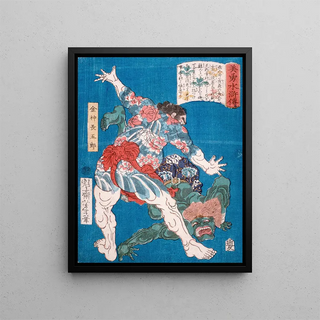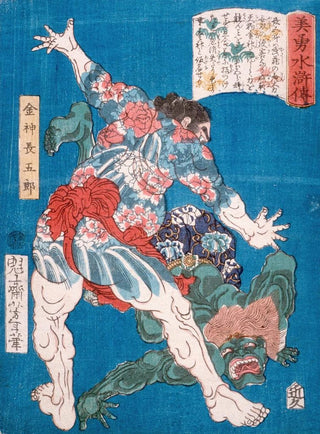Art print | The wrestler Konjin Chōgorō throwing a demon - Tsukioka Yoshitoshi


View from behind

Frame (optional)
In the fascinating world of Japanese ukiyo-e, the art print "The Wrestler Konjin Chōgorō Throwing a Demon" by Tsukioka Yoshitoshi stands out for its compelling narrative and striking aesthetics. This iconic piece, which depicts a moment of confrontation between the human and the supernatural, transports viewers into a world where courage and determination intertwine with mythology. Yoshitoshi, an undisputed master of ukiyo-e, masterfully captures the intensity of a battle that is both physical and spiritual, inviting everyone to explore the depths of Japanese culture through a modern and bold perspective.
Style and uniqueness of the work
The art print is characterized by a masterful use of colors and lines, typical of Yoshitoshi's style. The vibrant hues and dramatic contrasts bring the scene to life, while the meticulous details of facial expressions and character postures demonstrate exceptional craftsmanship. The wrestler, symbolizing bravery, is frozen in a dynamic movement that evokes both physical strength and spiritual energy. Symbolic elements, such as the demon, add a mythological dimension to the piece, transforming a simple fight scene into an allegory of the struggle against dark forces. This ability to fuse reality and fantasy makes this art print a masterpiece, where each glance reveals new layers of meaning and emotion.
The artist and his influence
Tsukioka Yoshitoshi, born in 1839, is often regarded as the last great master of ukiyo-e, an artistic movement that flourished during the Edo period. His work is marked by an unceasing quest for perfection and a desire to renew the genre, incorporating contemporary elements while remaining faithful to traditions. Yoshitoshi skillfully navigated between Western influences and Japanese cultural roots, creating a unique style that has left a lasting mark on art history. His impact on his contemporaries and future generations is undeniable, as he paved the way for a new aesthetic that continues to inspire artists today.

Matte finish

View from behind

Frame (optional)
In the fascinating world of Japanese ukiyo-e, the art print "The Wrestler Konjin Chōgorō Throwing a Demon" by Tsukioka Yoshitoshi stands out for its compelling narrative and striking aesthetics. This iconic piece, which depicts a moment of confrontation between the human and the supernatural, transports viewers into a world where courage and determination intertwine with mythology. Yoshitoshi, an undisputed master of ukiyo-e, masterfully captures the intensity of a battle that is both physical and spiritual, inviting everyone to explore the depths of Japanese culture through a modern and bold perspective.
Style and uniqueness of the work
The art print is characterized by a masterful use of colors and lines, typical of Yoshitoshi's style. The vibrant hues and dramatic contrasts bring the scene to life, while the meticulous details of facial expressions and character postures demonstrate exceptional craftsmanship. The wrestler, symbolizing bravery, is frozen in a dynamic movement that evokes both physical strength and spiritual energy. Symbolic elements, such as the demon, add a mythological dimension to the piece, transforming a simple fight scene into an allegory of the struggle against dark forces. This ability to fuse reality and fantasy makes this art print a masterpiece, where each glance reveals new layers of meaning and emotion.
The artist and his influence
Tsukioka Yoshitoshi, born in 1839, is often regarded as the last great master of ukiyo-e, an artistic movement that flourished during the Edo period. His work is marked by an unceasing quest for perfection and a desire to renew the genre, incorporating contemporary elements while remaining faithful to traditions. Yoshitoshi skillfully navigated between Western influences and Japanese cultural roots, creating a unique style that has left a lasting mark on art history. His impact on his contemporaries and future generations is undeniable, as he paved the way for a new aesthetic that continues to inspire artists today.






